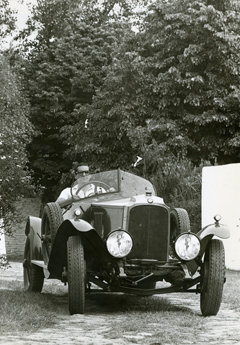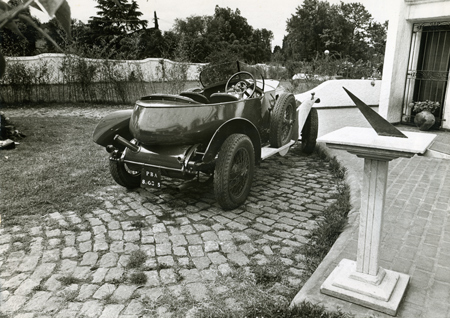

By ENRIQUE SÁNCHEZ ORTEGA
This time it was our turn to make the note of the car that, for many experts, is the most beautiful and successful exponent of the vintage period we have in Argentina. In impeccable state of conservation, with its mechanics delivering the same performances as in its heyday, the Vauxhall 30/98 alone tries to objectively confirm this judgment. We just visit it and track its history.
In the last three or four years, the expensive fever of car restorers has become alarming. Thanks to this crazed desire, a significant number of really extraordinary cars were put back into circulation. They appeared again Mercedes SS, SSK, reborn some Bugatti, respected honorable veterans, a Jaguar 100 Miles; in short, that more than one chicken coop was left without a bedroom for laying hens ...
All these newcomers to the world come to share the places in the private collections with those others "as important and beautiful as the recently finished" that, being here years of years, are the theme remanido in the gatherings of the fanas. And among all the lots of coveted pieces that were always there, one stands out for its beauty and its characteristics: the famous Vauxhall by Chuzo González. An impeccable 30/98 that Chuzo kept until the day of his death. A car with a story so similar to that of many of his thoroughbred brothers. Controversial, if you like, because for many it was always the cutest vintage in Argentina. The Vauxhall of Chuzo González took away the sleep of more than one collector with mechanical inclinations, Anglophiles or not.
Jorge Malbrán and Lucio Bollaert are attributed the finding of the car. When I was already to buy it. Because until that exact moment he was one of the many who had always been from a family and who had also almost always been in a shed in the family camp.
The Vauxhall 30/98 of this note was imported into the country by the Harrods house, which at the time was also selling cars. He was exposed in his shop windows until the Merlo family bought it. Apparently, from Florida Street he went for Arrecifes payments (where these people had fields) and from there he left one day with another owner. In the hands of this man begins the known history. She comes to Buenos Aires and is bought by Chuzo González, who had a workshop in partnership with Malbrán.
Five years ago Chuzo died. The car was in succession and one day went to auction. Needless to say the importance of the auction, as the cream of the exporters came to buy it, yes or yes. But the offers went up to such a height that it surpassed them. Struggling for the other side "happily" there was also an important group of collectors bent on keeping the car from leaving the country. And it was in San Isidro.
Obviously the value of Vauxhall goes beyond local affection. The origin of this particular model dates back to 1913, when the factory developed a prototype model based on the successful Prince Henry, designed by Laurence Pomeroy father. From that order of a Mr. Higginson, the 30/98 in its different and successive series remained in production for almost 14 years. Before the First World War, only six copies were built. And throughout those almost 14 years, only 600 cars left the house. His strength was not the races, and year after year, despite the introduction of improvements, he always maintained the main characteristics of the original archaic model. Despite this, 30/98 went down in history as one of the most classic vintage produced by British industry.
The first reason why Vauxhall began the production of the model is to look for it in the philosophy that moved the manufacturers in those years of the second decade of the century, full Edwardian period, when it was already clear that the success in sales it was directly and intimately related to sporting triumphs. Vauxhall Motors Limited, among them, was under the direction of a heterogeneous combination of enthusiastic athletes and a group of engineers. Thanks to them, as early as 1912 the brand had gained a certain reputation among the car builders of tourism with clear speed characteristics, light and with a respectable resume harvested in mountain climbs and races of different types.

The origin of the acronyms that identified it come from 30 HP at 1000 rpm and the maximum 98 HP that make this interpretation a bit obscure, since the factory catalog did not include this last figure.
Throughout the period of the First War (1914-1918), the house was dedicated to provide certain models to the army, etc. This served to maintain it in full activity in those years of industrial retraction. That gave them the great advantage of coming already packed when in 19 the production of cars on a large scale resumed. The 30/98 was then to be the most important model among those offered by the brand. It did not take long to become the sports car par excellence (its predecessor, Prince Henry, is considered the first English sports car), requested by the groups that had access to that class of machines probably because it was also the fastest car in the world. how many then British industry produced.
When facing the production of the car in this way, a second period begins for 30/98, when the fame of which we have spoken is gained: the type E that was kept in the catalog from 1919 to 1922 is born.
The importance of the factory had grown accordingly. It already employed 2000 people, but due to the same characteristics of the production models "refined, absolutely well-built, quite expensive", there is an obligation to judge 30/98 very carefully. Put in critical of some of their designs and mechanical solutions, we must take into account that the production was very limited and did not justify a development program with everything. A total of 270 cars of the E series were produced.
In 1920, Laurence Pomeroy "in a certain way factotum of 30/98" had left for the United States. However, he had finished a project that included a new engine with the overhead camshaft for 30/98. C. E. King, successor of Pomeroy, proposed to change the models of the house (type D of 25 HP and 30/98) to update them rethinking the integral design. The industrial limitations imposed that the changes arrived until a new design of valves to the head (lateral camshaft) for the two models in the first months of 1923. Thus it sees the light the new 30/98 denominated OE. Thus begins the third stage of the life of the car and which will be the most interesting.
The renewed 4-cylinder engine maintained the lower part equal to that of the E, but instead of the old and so "Edwardian" lift-valves in the air, the new cover included internal duralumin rods, which acted on the extremely long valves. From the factory it came out with two springs per valve and this, together with the generous diameter of each of them, was the key to the improvement and the excellent performances of the engine. Although less shocking than the old E, the engine delivered 112/115 HP at 3300 rpm. Another innovation, which (like the rod-lift valves) arose from the need to keep the reciprocal weights as low as possible, made the "four-bolt" cranks were made of duralumin. The Dural had been patented by Vickers for the construction of aircraft structures. But the choice of this material for the construction of cranks was something really advanced for 1922. That made the engine much quieter than the previous one of steel cranks.
The stroke of the pistons was reduced to 140 mm (the previous one had 150 mm), forced by the compromise contracted with the design with respect to the height of the radiator and the highest motor by the valves at the head.
Inexplicably, the EO was also not equipped with brakes on the front wheels. Model tradition from Prince Henry. It was not until the end of 1923 that a relatively effective system of cable brakes was added to the front wheels. At the beginning it was offered as optional.

The OE series continued to maintain the excellent characteristics of "remarkable since the model was born". In 1923 this feature became imperative, as the car easily reached 165 km / hour. This catalog speed is even today confirmed in the ride of the car that we had to visit. In the Panamericana we traveled with a Torino whose speedometer (with a certain percentage of error, obviously) reached 170 km / hour.
The ride is more than outstanding, the technical characteristics of the engine are second-rate because the hood covers them. Therefore, the most notable feature of the car, which stands out at first sight, is the beauty of its body. The balance of its lines. Despite being a large car, the design was treated in such a way that makes the car light, aggressive, eminently sporty, absolutely accomplished.
The Vauxhall in question has a body of Wensum, which was one of the options given by the factory to those interested. Already the day it was presented for the first time (in the Week of Speed in Boulogne) in 1924 caused a sensation. Modeled with an absolutely nautical and refined style, with a tendency to Luton designs, it lacks doors and the entire interior, like the upper part of the tail, is clad in polished wood. With its fenders with an exquisite wing shape, nautical appearance and very successful stern, this model of the OE series sold much more expensive than the Velox standard. And it turned out to be one of the most beautiful English cars of the mid-20s. The factory advertised it as "an ultra sporting body for a very fast or running tourism".
The last series suffered certain improvements in the crankshaft (lower part of the engine, which was not revised from the E) and increased the diameter of the benches. Thus the 120 HP at 3500 rpm were reached.
At the end of 1924 production began to decline and until 1925 only about fifty chassis left the factory. The competition of Bentley and Sunbean was killing and calling the end of this classic. The possibility of having a 4.3 liters for a few pounds more than a 3-liter Bentley was not enough argument.
The refinement and speed of these latest OE series was not what was being questioned. But by 1927 there were almost no buyers. One every so often. The last baked was made in November 1926 and ended in the first months of 1927. The OE (the last, only 310 cars were built) was sold in July 1927. And that was the end of the line. Cars, like men, go through a cycle, age and die. The proud and proud athlete of the first pre-war had finished his cycle. Because he, also like men, had preserved the characteristics and the defects with which he was born. Its clutch, rear axle, distribution, steering and chassis design remained essentially the same in 1927 as it was when it was born in 1913. "Those were his faults, but they were the defects of a genius," the epitaph says in a note written in England.
For the purists, however, the reason for his death is quite another: in 1925 Vauxhall became part of General Motors USA ...
ARTICLES OF VOLUME II
 Anasagasti was the first
Anasagasti was the first I started running there in 1908
I started running there in 1908 Mercedes Benz SSK
Mercedes Benz SSK Vauxhall 30-98 Tipo OE 1924
Vauxhall 30-98 Tipo OE 1924
| Contact: (+549) 11 4027 8262 / sancho1978@gmail.com |
| Home | Volume I | Volume II | Volume III | News | Photo Gallery | Contact |